Price Check Q3 2016: DRAM Prices Down Over 20% Since Early 2016
by Anton Shilov on July 25, 2016 12:01 AM ESTDDR3 Modules Are Getting Cheaper Too
While the transition to DDR4 is proceeding as planned, there are a number of competitive Haswell and Skylake processors that support DDR3 and DDR3L memory. Therefore it makes sense to examine retail prices of previous-generation modules in retail too. While most users building new high end systems will be leaning on DDR4, we recognise that mid-range and low cost buyers may still be buying older platforms as new. As a result, we will analyze several mainstream speed bins for DDR3.
Kingston’s HyperX Fury Low Voltage DDR3L-1866/CL11 16 GB (2×8 GB) kit (HX318LC11FBK2/16).
Intel’s newest processor line, the Skylake CPUs, officially supports DDR3L as well as DDR4 memory, if you find the appropriate motherboard. Note that it is DDR3L and not DDR3, due to the memory controller implementation. As a result, we start with Kingston’s HyperX Fury Low Voltage DDR3L-1866/CL11 16 GB (2×8 GB) kit (HX318LC11FBK2/16). Very early this year the set retailed for $90, but its price fell to $83 in February. By now, the price of this dual-channel DDR3L-1866/CL11 kit dropped to $73 at Amazon and $73 at Newegg, which is somewhat higher than the price of mainstream dual-channel DDR4-2133/CL15 or even DDR4-2400/CL16 kits, which retail for less than $65. The gap between DDR4-2133 and DDR3L-1866 got a little smaller than it was earlier this year, but being less widespread in general, the DDR3L is a bit more expensive.
Kingston’s HyperX Fury Black DDR3-1866/CL10 (2×8 GB) kit (HX318C10FBK2/16)
If you need to upgrade a previous-generation platform, you can opt for Kingston’s HyperX Fury Black DDR3-1866/CL10 16 GB (2×8 GB) kit (HX318C10FBK2/16), which retails for $69.99 (in line with prices of mainstream DDR4 modules). This kit used to cost around $80 early this year, so, it has got over 13% cheaper in the recent months. The dual-channel set of DDR3 memory modules briefly retailed for $53 in early June, so, it is possible that in the coming weeks its price will hit that spot again.
Kingston’s HyperX Savage DDR3-2133/CL11 2×8 GB kit (HX321C11SRK2/16)
If you need fast DDR3 modules, then Kingston (as well as other makers) offer DDR3-2133 DRAM sticks.
For example, Kingston’s HyperX Savage DDR3-2133/CL11 16 GB (2×8 GB) kit (HX321C11SRK2/16) costs $99.99 at Amazon, up from $90 earlier this year (but down from over $100 last year). For this amount of money, it is possible to get 16 GBs of DDR4-3200/CL17 memory.
Kingston’s HyperX Savage DDR3-2400/CL11 (2×8 GB) kit (HX324C11SRK2/16)
If you plan to push your DDR3 memory sub-system even further, you may want to consider Kingston’s HyperX Savage DDR3-2400/CL11 16 GB (2×8 GB) kit (HX324C11SRK2/16), which costs $100 at Amazon (so, the same amount of money as the DDR3-2133 kit). Earlier this year this dual-channel set of DRAM modules cost over $100 and its current price is around the same.



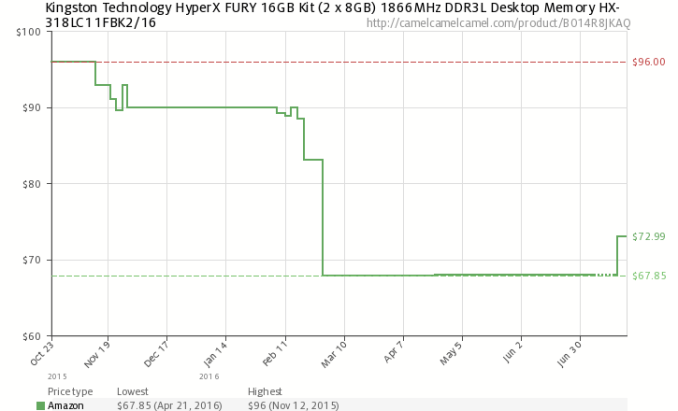
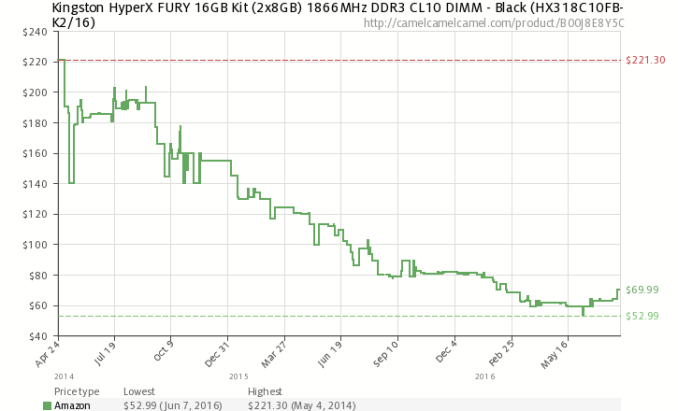
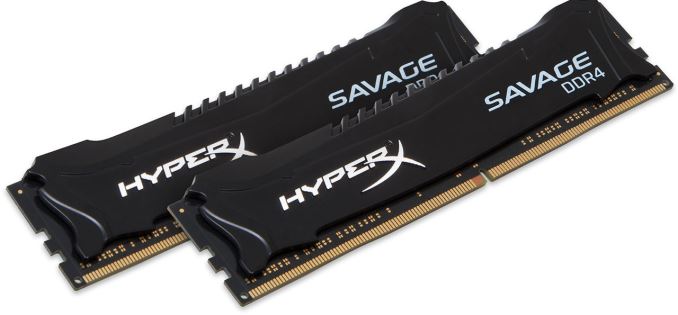
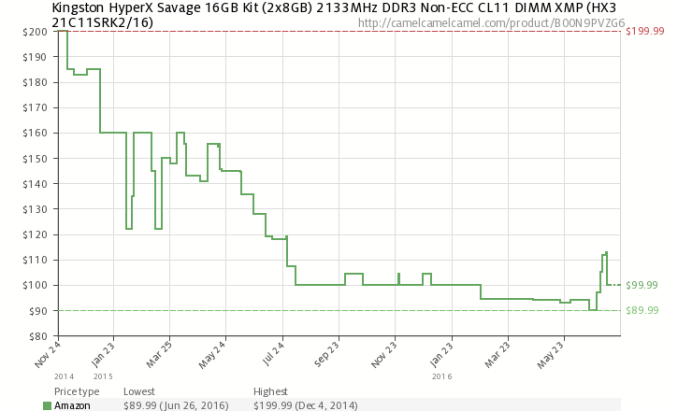
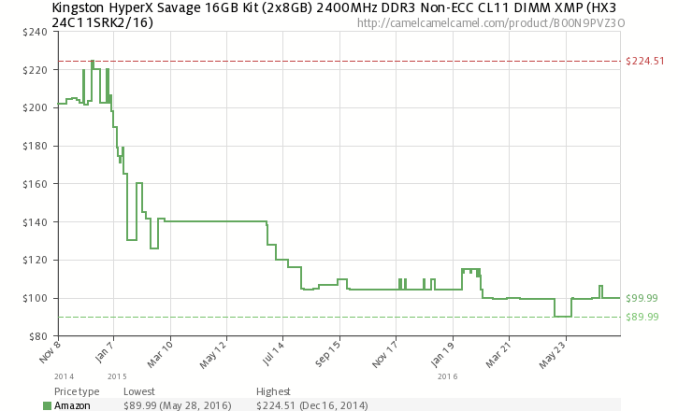








37 Comments
View All Comments
invasmani - Monday, July 25, 2016 - link
The majority of American's that actively live in the northern states most impacted by the Keystone pipeline deal were in favor of it. It's the fault of Obama and democrats who tried to make it into a big environmental issue despite the fact that a pipeline is much safer than railroad transport.catboy - Tuesday, July 26, 2016 - link
tipoo is correct. Corporations scam Canadians with outrageously unfair prices just because they can. Here is a news report about that fact:http://www.cbc.ca/news/canada/country-pricing-a-ca...
Of course, that report is not about hardware, but Canadians get price gouged on hardware in the same way as they do on all other products.
I recommend for Canadians to stop buying products from Canadian sellers whenever possible. If enough Canadians do that, then corporations will end the practice of price gouging Canadians.
doggface - Tuesday, July 26, 2016 - link
Same thing happens in Australia. $160 in USD = $350-$400 in AUD.The manufacturers price items much lower in the US to get the buzz from websites like these. Then mark it up in lower volume countries.
Another example. $US600 for GTX1080 = $AUD1150
Sure. Our dollar is lower. But it doesnt account for the massive discrepency. We call it the Australia tax
Arnulf - Monday, July 25, 2016 - link
I find it intriguing that Samsung has been producing complex circuits on 14 nm node for some time now yet they are only switching to 18 nm for DRAM production (which should be more dense).DanNeely - Monday, July 25, 2016 - link
Somewhere around half a DRAM die is made up of analog components used to terminate signals on the database; and unlike the digital circuits in the ram cells themselves analog components scale minimally with process shrinks. As a result DRAM gets less of a benefit from process improvements than things like CPUs/GPUs/Flash that are almost all digital components on the die. The analog penalty has gotten worse with each new generation of DDR because to keep the data bus stable at higher frequencies the termination components need to be moved closer to the DRAM; leading to a steady migration of them from the mobo to the dimm to the dram chips themselves.p1esk - Monday, July 25, 2016 - link
Source? Everything is analog of the circuit level.DanNeely - Monday, July 25, 2016 - link
It was something I read back when the DDR4 spec was first released so I'm having trouble finding it (will look more later); but analog components are things that aren't transistors eg resistors, capacitors, inductors (also power transistors which need to be a certain size to carry the amount of current that they do or a lot of RF components; but neither of them are a factor here). Physical size is a major component in how they perform. ex Make a capacitor half as large and all other things equal it's capacitance is only half as great.It's one of the factors behind why the minimum size dimm goes up every time there's a new process. The lower capacity dram chips see the least shrinkage because the largest fraction of their die is signal termination components that don't shrink much.
yuhong - Tuesday, July 26, 2016 - link
I guess that is why they often eventually drop things like x4 configurations when moving older DRAM like 1Gbit DDR2 to newer processes.jardows2 - Monday, July 25, 2016 - link
I built my current computer in 2102, and purchased 8 (2x4) gigs of DDR3-1600 RAM. Thinking I could eventually upgrade to 16 gigs if needed, but then memory prices shot up. I can finally purchase the same RAM I did 4 years ago at a slightly lower price, instead of a significantly higher (at times was double what I paid) price!bananaforscale - Monday, July 25, 2016 - link
I built mine in late 2011 and bought 4x4 GB of DDR3-1600. Decided to upgrade the memory past winter, the price per GB was still about the same for the DIMMs I used, but doubling the amount and buying faster memory wasn't that much more expensive -> went from 16 GB 1600 to 32 GB 2133 (except the CPU only supports 1866 but whatevs) and distributed the old memory among less important hardware.